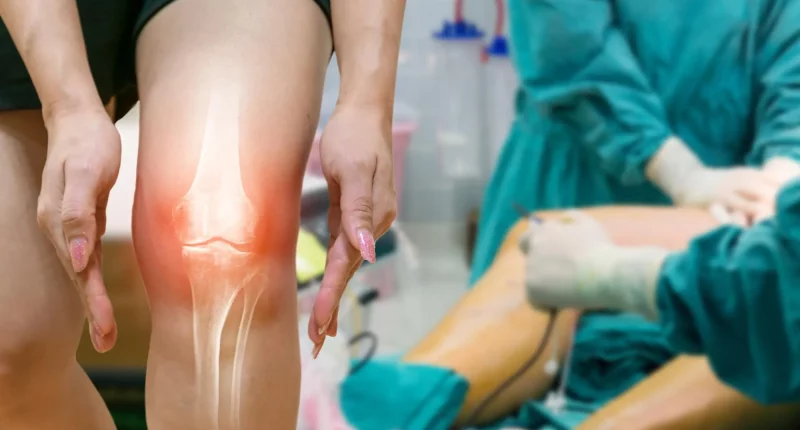Cartilage is a type of connective tissue that is found in various areas of the body. While it is flexible and tough, cartilage can be easily damaged. In some serious cases, a piece of cartilage may even break off.
This smooth, rubbery tissue serves an important function in our joints by acting as a cushion between bones, helping them move smoothly and preventing them from rubbing against each other. When cartilage is damaged, it can lead to stiffness, joint pain, and swelling. Individuals with cartilage damage often experience discomfort and difficulty moving the affected joint.
What is Cartilage?
Cartilage is a type of connective tissue in the human body with several important functions. It decreases friction and works as a cushion in the middle of joints, allowing for smooth movement and supporting our weight when we bend, run, or stretch. Cartilage also helps hold bones combining, such as those in the ribcage. Many body parts, like the external areas of our ears, are made almost completely of cartilage. In children, the ends of long bones are initially made of cartilage, which gradually turns into bone as they grow.
Not like other tissues, cartilage doesn’t have its own blood supply. This lack of blood flow means that damaged cartilage heals much more slowly than tissues that receive blood.
Types of Cartilage
There are three main kinds of cartilage: fibrocartilage, elastic cartilage, and hyaline cartilage.
- Fibrocartilage is the toughest type, designed to withstand heavy weights and pressure. It is located between the vertebrae and discs of the spine and in the middle of the bones of the pelvis and hip.
- Elastic cartilage is the most flexible and springy type. It is found in the outer parts of the ears and parts of the nose.
- Hyaline cartilage is both springy and tough, providing support in areas like the ribs, over the windpipe, and in the middle of joints.
All three types of cartilage can be damaged. For instance, a slipped disk is a form of fibrocartilage damage, a strong blow to the ear can damage the elastic cartilage.
Impact of Cartilage Damage
When the cartilage in a joint is damaged, it can cause heavy pain, inflammation, and sometimes disability. This condition is called articular cartilage damage. As stated by the National Institutes of Health, about 1/3rd of American adults over the age of 45 experience some form of knee pain, often related to cartilage issues.
Symptoms
When cartilage in a joint, known as articular cartilage, is damaged, patients may experience several symptoms. One of the most common symptoms is inflammation, where the affected area swells, becomes warmer than other areas of the body and is sore, sensitive, and painful. This inflammation can lead to stiffness, making it difficult to move the joint freely. As the damage progresses, there may be a limitation in the range of motion, meaning the affected limb cannot move as easily or as far as before.
Articular cartilage damage most commonly occurs in the knee, but it can also affect other joints such as the wrist, elbow, ankle, hip, and shoulder.
In severe cases, a piece of cartilage can break off and cause the joint to lock up. This situation may cause hemarthrosis. When this occurs, the affected area may become blotchy and have an injured appearance, indicating internal bleeding and increased severity of the injury.
Causes
Cartilage damage in joints can occur due to several reasons. One common cause is a direct blow to the joint, such as from a heavy impact during a fall or a car accident. Athletes, particularly those included in high-impact sports such as American rugby, football, and wrestling, are at a higher risk of experiencing this type of damage due to the physical demands and impacts of their sports.
Another cause of cartilage damage is wear and tear over time. Joints that endure prolonged stress can deteriorate, leading to damage. For instance, obese people are more possibly to suffer knee damage over a 20-year time compared to those of normal weight, as the excess weight places additional stress on the joints. This type of gradual cartilage damage, characterized by breakdown, inflammation, and loss of cartilage, is called osteoarthritis.
A lack of movement can also contribute to cartilage damage. Regular movement is essential for maintaining joint health, as it helps to nourish the cartilage and keep it functioning properly. Extended periods of immobility or inactivity can increase the chance of cartilage damage, as the joints are not receiving the movement they need to stay healthy.
Diagnosis
Distinguishing cartilage damage in the knee from a sprain or ligament injury can be challenging because the symptoms are often the same. But the modern non-invasive tests have made it easier to diagnose the condition.
After a physical examination, a healthcare provider may recommend further diagnostic tests to confirm the presence and extent of cartilage damage. One common test is Magnetic Resonance Imaging, which uses radio waves and a magnetic field to create clear images of the body’s internal structures. While MRIs are helpful, they do not always detect cartilage damage accurately.
Another diagnostic procedure is arthroscopy, where a tube-like instrument called an arthroscope is inserted into the joint. This allows the healthcare provider to directly examine the joint and assess the extent of the cartilage damage. Additionally, arthroscopy can sometimes be used to repair the damage during the same procedure.
Treatment
Treatment for cartilage damage can be either conservative (non-surgical) or surgical, depending on the severity of the condition and the patient’s response to initial treatments.
Many patients benefit from conservative treatment, which includes special exercises, non-steroidal anti-inflammatory drugs, and occasionally steroid injections. Exercises may involve physical therapy sessions or a home exercise program tailored to the patient’s needs. If the cartilage damage is not major, these non-surgical methods may be sufficient to manage the condition effectively.
If conservative treatment does not provide relief, surgical options may be necessary. The choice of surgery depends on several factors, including the patient’s age, activity level, the size of the cartilage lesion, and the time elapsed since the injury.
Debridement
This procedure involves smoothing the damaged cartilage and eliminating loose edges to prevent irritation. It is performed using tiny arthroscopic instruments, like a mechanical shaver.
Mosaicplasty
Healthy cartilage is taken from one part of the joint and transplanted to the damaged site. This procedure is suitable for isolated areas of damage, usually up to 10 to 20 millimeters in size. It is most effective for patients under 50 who have cartilage damage from an injury, rather than widespread conditions like osteoarthritis.
Marrow Stimulation
In this technique, the surgeon drills small holes into the bone beneath the damaged cartilage, exposing blood vessels. This process encourages the formation of a blood clot, which helps generate new cartilage. However, the new cartilage is usually less flexible and wears out more rapidly, which might mean the patient requries more surgery in the future.
Autologous Chondrocyte Implantation
A tiny piece of cartilage is eliminated and sent to a laboratory where it is cultured to produce more cartilage cells. After 1 to 3 months, these new cells are implanted into the damaged area of the knee, where they develop into healthy tissue.
Each of these surgical techniques aims to restore joint function and decrease pain, with the choice depending on the specific needs and conditions of the patient.
Complications
If cartilage damage is not treated, it can lead to serious complications. For example, in weight-bearing joints like the knee, the damage can become so severe that a person may eventually lose the ability to walk. Besides making movement difficult, the pain can gradually worsen over time.
Even small defects in articular cartilage can get worse and develop into osteoarthritis if left untreated for a long period. Osteoarthritis is a condition where the cartilage in the joint breaks down completely, leading to pain, stiffness, and reduced joint function. Therefore, it is important to address cartilage damage early to prevent these severe complications.
Summary
Cartilage is a flexible tissue that cushions joints and helps them move smoothly. Damage to cartilage can result from impacts, wear and tear, or lack of movement. Symptoms include pain, stiffness, and reduced range of motion. Treatment options range from conservative methods like physical therapy and NSAIDs to various surgical procedures. If left untreated, severe cartilage damage can lead to immobility and worsen pain, potentially progressing to osteoarthritis. Early diagnosis and treatment are crucial to manage symptoms and prevent complications.







